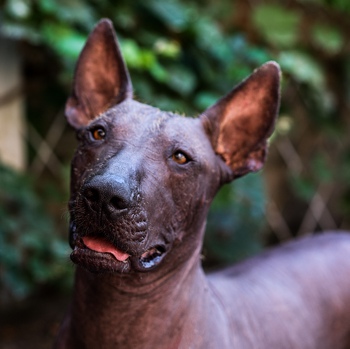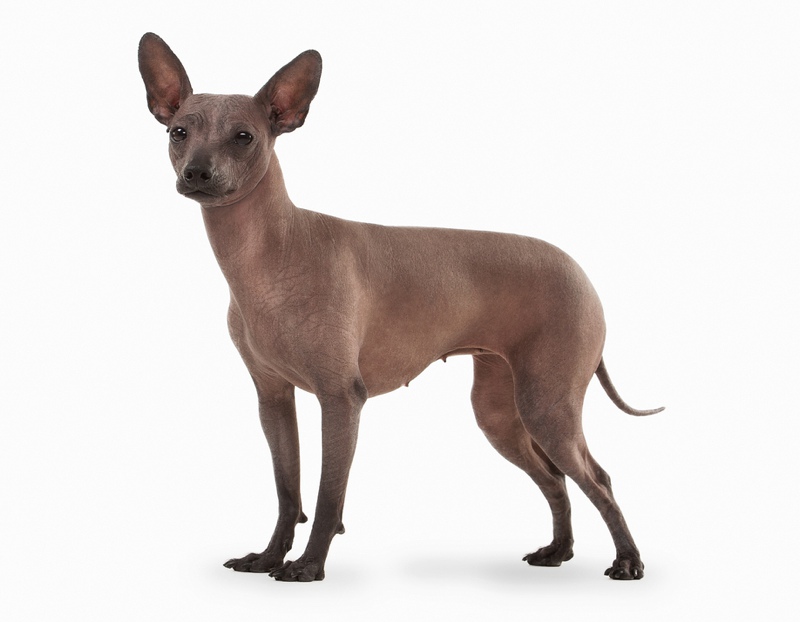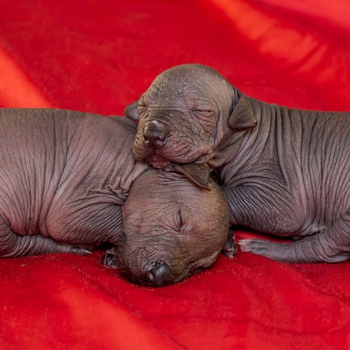Xoloitzcuintli

Over the course of its long history, the Xoloitzcuintli (a.k.a. the Mexican Hairless Dog) has found itself in several roles: companion, hunter, healer, and sometimes, unfortunately, a source of food. Undoubtedly, the first domesticated dog of the Americas, this unusual breed evolved, rather than being selected by man, over many centuries, and it therefore exhibits many of the typical “primitive” features seen in other such breeds, for example the Canaan Dog.
Some of these features are very positive, such as the breed’s excellent health and high intelligence, but others, including its headstrong, stubborn nature and willingness with strangers to bite first and ask questions later, can present a challenge to owners without a great deal of dog ownership experience.
Xoloitzcuintli form especially strong bonds with one favourite person, although they are affectionate, cuddle-loving family dogs. Despite their very unusual appearance, they are feisty and hardy dogs, and will protect their homes and family with vigour, do not back down from a fight, and are not averse to pursuing cats and other small pets as prey. The breed standard recognises many variations on the Mexican Hairless theme, with toy, miniature, and standard sizes, and both hairless and haired individuals being seen – all of which exhibit the personality considered typical of the Xoloitzcuintli. Owners can expect to enjoy the company of their unique canine hot-water bottle for around 13 to 15 years.
About & History
An abundance of archaeological evidence, in the form of skeletons and representations on pottery and other works of art, proves that the Xoloitzcuintli arrived to America well over 3000 years ago, crossing the now-submerged land of the Bering Straits with migratory humans. While it was probably first valued as an aid to hunting, with the emergence of the Aztec empire it gained new significance as an earthly representative of Xolotl, the god of fire.
When we consider that the Aztec word for dog was “itzcuintli”, it becomes immediately apparent how the breed acquired its name. The Aztecs believed (as many people still do) that the Xoloitzcuintli possessed the power to heal the sick, particularly those suffering from rheumatism, asthma, and various other painful conditions. No doubt, this belief arose because of the comforting heat that the Xoloitzcuintli’s skin provides.
Unfortunately, however, the god Xolotl was also responsible for escorting the dead to the afterlife, and so his canine assistants were required to do the same, being sacrificed to ensure a smooth passage for the deceased. The dog was also thought of as a delicacy, but its meat would only have been routinely consumed during religious ceremonies, especially funerals.
However, the Conquistadors did report being served dog meat at banquets in the sixteenth century, so it was not exclusively a ceremonial food. Over the course of the twentieth century, the Xoloitzcuintli has gone through brief spells of being thought to be extinct, but although it remains a rare breed, a network of enthusiasts are now ensuring its continued survival.
Appearance

The Xoloitzcuintli’s appearance is like Marmite – people either love it or hate it. Although many seem unable to look past its hairlessness, it is an attractive, slim dog, unspoiled by human attempts to emphasise or exaggerate any physical characteristic. Well proportioned, with a slightly elongated, broad back, it has a muscular rump and well-angulated, strong limbs. Its elegant head is wedge-shaped, with a smooth, tapering profile, a slight stop, and a square, strong jaw and muzzle.
The pigmentation of the nose, eyelids, and lips can vary considerably, in keeping with that of the skin, and it is common to find dark spots on the tongue and mucous membranes of the oral cavity. It is also not unusual to find that many of the Xoloitzcuintli’s incisors and premolars are absent, as these teeth have very shallow roots. It has expressive, alert eyes that are almond-shaped and medium in size, and it is often described as “bat-eared” by virtue of their large, triangular outline and upright carriage.
Regardless of its size, the Xoloitzcuintli always has a long, broad, and deep chest, and a markedly tucked-up, slim abdomen. It is difficult to describe its tail as anything other than rat-like, as it is long, thin, and sparsely covered in hair. It is carried in a curl, but should not reach the back. The major characteristic of this breed is, of course, its coat – or lack thereof.
Hairless individuals should have smooth, healthy skin (which is not always the case), and possess sparse, coarse hairs on the forehead and along the top of the neck, though these should not exceed around an inch in length. Likewise, the tail may have some of these hairs, especially towards its tip. Haired dogs have a single-thickness, short, smooth coat that can be any of the following colours or a combination of them:
- Black
- Grey
- Red
- Liver
- Bronze
- Blonde
In hairless dogs, the skin should ideally be uniformly dark, though it is more frequently spotted with various colours, and the few hairs it does possess can be any of the colours listed above. The breed comes in a range of sizes:
| Toy | Miniature | Standard | |
|---|---|---|---|
| Height | 25-35 cm | 36-45 cm | 46-60 cm |
| Weight | 6-10 kg | 10-17 kg | 17-23 kg |
Character & Temperament
Mischievous and often destructive as a pup, the Xoloitzcuintli matures into a mellow companion, though it is extremely watchful and wary of strangers. It is a dog that loves physical contact with its owners, particularly with its favourite member of the family, as it loses a lot of heat through its bare or lightly covered skin. But this is not to say it’s a softie! A Xoloitzcuintli will rarely back down from a confrontation, whether with an unfamiliar person or another dog, and it has a strong personality.
Its high intelligence means it likes to think for itself, and it can therefore be stubborn. This is a primitive breed that needs an experienced owner who can handle the dog’s antics in a calm but assertive manner; if left to behave as it pleases, the Xoloitzcuintli can become a pet that is difficult to enjoy. Although it can adapt to be a perfectly suitable family pet, it needs to be brought up with children, and to be spared from rough handling or constant annoyance, as it will snap if it feels itself pestered or backed into a corner.
Trainability

The ease with which a Xoloitzcuintli can be trained is again, very much dependent on the owner doing the training. It will quickly figure out whether it can get away with disobedient or inappropriate behaviour, and make the most of whatever leeway it finds available. However, because of its innate cleverness, it can be trained to a very high level by someone who can anticipate it pushing the boundaries and is prepared to respond appropriately.
Patience, and a firm, consistent approach are required, but will yield dividends. Socialisation is important for all dogs in the first few months of their lives, but especially so for this breed, as it is instinctively distrustful of strangers.
Health
The breed is almost entirely free from inherited illness, having not been intensively or selectively bred for the vast majority of its long history. The only issues of note relate to its skin. Without the dense protection afforded to almost every other dog, it is at risk of developing the sorts of problems seen in many of us equally hairless humans – acne, folliculitis, and blackheads – which can largely be prevented through good grooming practices, as described below.
Exercise and Activity Levels
Xoloitzcuintlis are naturally athletic, but are very adaptable, and can cope with relatively low levels of exercise and/or apartment living. About twenty to thirty minutes of walking twice daily is enough to satisfy their minimum requirements, but they can also keep pace with most joggers over distances of up to 5 km. However, bear in mind that these dogs require protection from both the cold and direct sunlight, and should always wear a suitable sunscreen product when outside in sunny weather.
Grooming
Grooming a Xoloitzcuintli is more about skin care than coat care, although haired dogs need to be brushed around once a week to encourage healthy hair growth and to remove loose hairs. Hairless skin produces more oily secretions, and it therefore needs to be cleansed with purpose-made wipes (available from pet stores and veterinary suppliers), for example – on a daily basis, especially between the toes and any skin folds.
In addition, owners should be prepared to bathe their Xoloitzcuintli every one to two weeks in a mild shampoo. These simple steps should prevent skin disorders developing in most dogs. In addition, most Xoloitzcuintlis need regular nail clipping, and they should ideally have their teeth brushed daily to prevent tooth loss and periodontitis.
Famous Xoloitzcuintlis
The Xoloitzcuintli hasn’t featured prominently in popular culture, although the famous painter, Frida Kahlo, was often pictured with her beloved Mr. Xoloti.
Cross-Breeds
The Xoloitzcuintli is not commonly used for cross-breeding, though it could probably produce some very interesting mixes!

